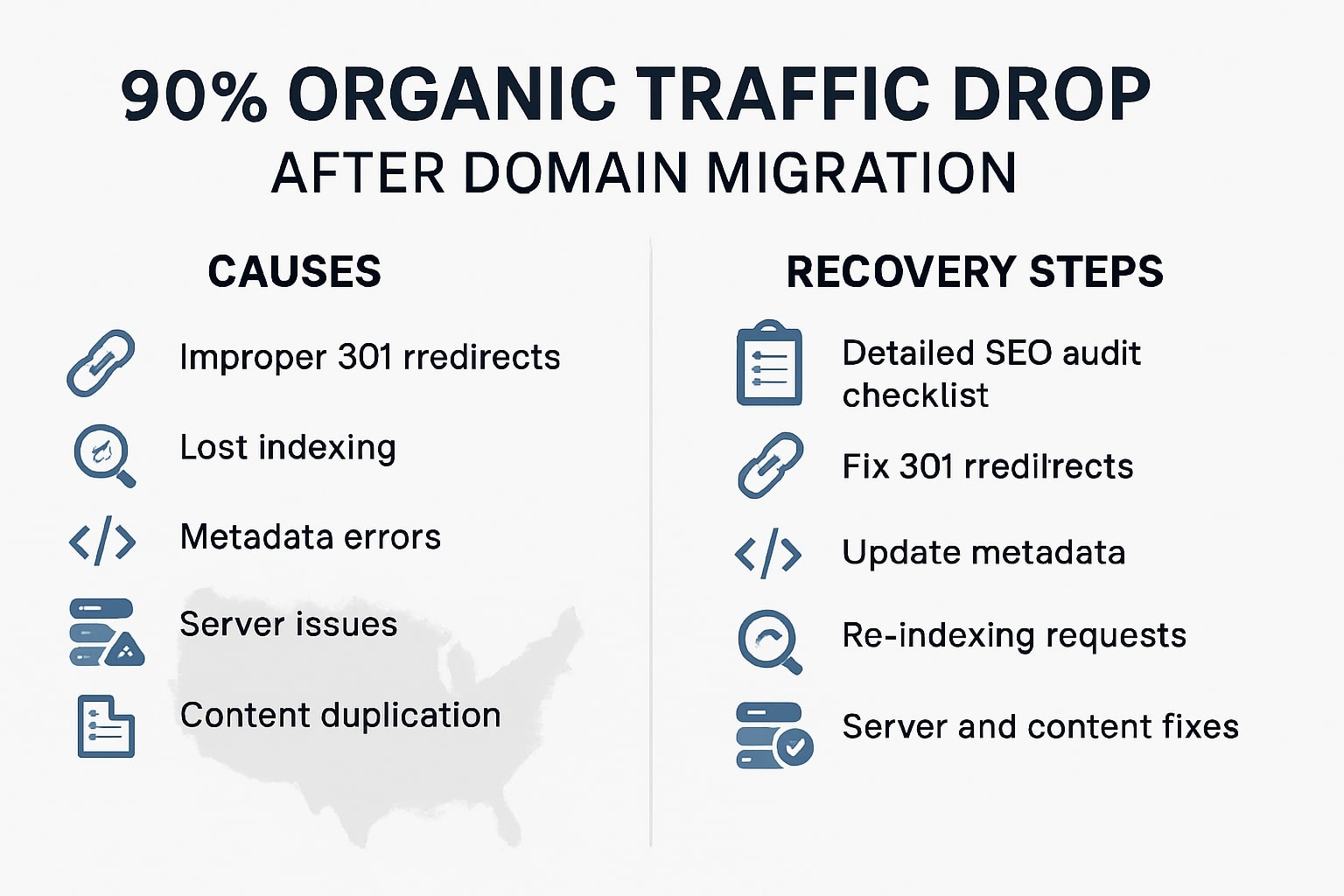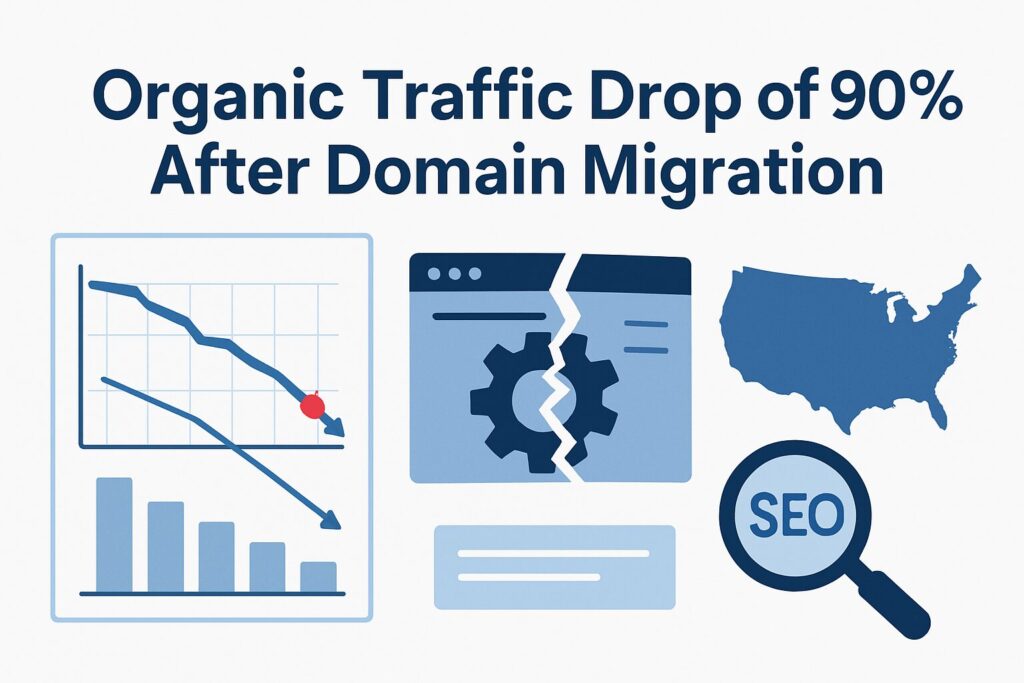Organic Traffic Drop of 90% After Domain Migration
A Deep Dive into SEO and Website Audit for USA Businesses
Domain migration is a critical event in a website’s lifecycle, especially for businesses targeting the USA market. While it can bring growth opportunities, it also carries significant risk—chief among them, a severe drop in organic traffic. Many websites suffer web traffic losses as steep as 90% after switching domains if not executed carefully.
Table of Contents
-
What Causes Organic Traffic Drops After Domain Migration?
-
Essential SEO Website Audit Steps Post-Domain Migration
-
Common Technical Pitfalls Leading to 90% Organic Traffic Loss
-
Best Practices to Prevent Organic Traffic Drop
-
How to Recover Your Organic Traffic Effectively
-
Trending FAQs About SEO and Website Audits After Migration
What Causes Organic Traffic Drops After Domain Migration?
A 90% drop in organic traffic after a domain migration is alarming but unfortunately not uncommon. This severe decline usually stems from one or more critical issues during or after the migration process.
Key Reasons Include:
-
Improper 301 Redirects: If old URLs aren’t permanently redirected to corresponding new URLs, search engines may lose the connection between existing indexed pages and new pages, causing a massive ranking drop.
-
Lost or Broken Metadata: Missing meta titles, descriptions, and header tags during migration can confuse search engines and harm rankings considerably.
-
Indexing and Crawlability Issues: Restrictive robots.txt files, missing or incorrect canonical tags, and mishandled sitemap files can prevent search engines from crawling or indexing the new domain correctly.
-
Content Changes or Inconsistencies: Even small content alterations or lack of keyword-rich content on migrated pages can reduce search relevance.
-
Google Search Console Misconfiguration: Failure to update, verify, or submit the new domain in Google Search Console prevents Google from recognizing and crawling your new site as expected.
-
Historical Domain or Hosting Issues: Not accounting for previous redirects or changes in domain history can result in loss of valuable SEO equity.
-
Technical Problems: Slow site speed, mobile responsiveness issues, or changes in platform/hosting can also impact SEO rankings dramatically.
Essential SEO Website Audit Steps Post-Domain Migration
Conducting a detailed website audit focusing on SEO is vital to diagnosing the reasons behind drastic traffic falls.
1. Confirm Proper 301 Redirects
-
Verify every old URL properly 301 redirects to its new counterpart, not just the homepage.
-
Use tools like Screaming Frog or Ahrefs to crawl all URLs and detect redirect chains, loops, or 404 errors.
2. Validate Metadata and On-Page SEO
-
Compare old and new site meta titles, descriptions, and header tags.
-
Restore any lost or damaged metadata, ensuring keywords are relevant to retain rankings.
3. Check Robots.txt and Sitemap Files
-
Ensure robots.txt does not inadvertently block important pages on the new domain.
-
Submit the updated sitemap in Google Search Console and Bing Webmaster Tools for indexing.
4. Analyze Indexing Status
-
Use Google Search Console’s Coverage Report to find pages not indexed or with errors.
-
Inspect canonical tags to prevent duplicate content or URLs pointing incorrectly.
5. Monitor Google Search Console Settings
-
Verify domain ownership and property settings.
-
Submit domain change notifications and check for manual penalties or security issues.
6. Evaluate Site Speed and Mobile Friendliness
-
Use Google PageSpeed Insights and Mobile-Friendly Tests to rule out performance factors affecting SEO.
7. Investigate Backlink Profiles
-
Check if backlinks still point to the new domain.
-
Use your website audit to identify lost or broken backlinks that hurt domain authority.
Common Technical Pitfalls Leading to 90% Organic Traffic Loss
-
Missing 301 Redirects: Redirecting only the homepage instead of page-to-page mapping.
-
Robots.txt Blocking: Accidentally disallowing Googlebot from crawling new URLs.
-
Broken Internal Links: Old URLs used within site content or navigation.
-
No Updated XML Sitemap: Sitemaps still reference old domain URLs.
-
Lost Metadata: Titles, meta descriptions removed or duplicated incorrectly.
-
Not Updating Google Search Console: No domain change request or verification delay.
-
Server Errors: 5xx errors or downtime post-migration.
-
Platform or CMS Configuration Errors: New site bundles content in a way difficult for crawlers.
-
Duplicate Content: Both old and new domains serving similar content without rel=canonical tags.
 Best Practices to Prevent Organic Traffic Drop
Best Practices to Prevent Organic Traffic Drop
-
Plan and test domain migration thoroughly in staging environments.
-
Use comprehensive URL redirect mapping (page-to-page 301 redirects).
-
Maintain consistent metadata and keyword usage.
-
Update Google Search Console and Bing Webmaster Tools appropriately.
-
Submit updated XML sitemaps after migration.
-
Avoid robot.txt or noindex issues.
-
Monitor site health, crawl stats, and index status daily for the first 90 days.
-
Communicate with customers and stakeholders about the migration and potential impacts.
How to Recover Your Organic Traffic Effectively
Conduct a Full SEO Website Audit
-
Identify and fix redirects, metadata, crawl, indexation, and backlink issues immediately.
Optimize Content with Keyword-Rich Material
-
Refresh historically high-traffic landing pages with updated, keyword-optimized content.
Fix Technical SEO Issues
-
Resolve any crawl errors, speed bottlenecks, mobile UX problems, and platform bugs.
Resubmit Sitemaps and Crawl Requests
-
Use Google Search Console URL inspection tool to prioritize important pages for crawling.
Monitor Rankings and Traffic Throughout
-
Track your key queries and URLs using tools like Google Analytics and Search Console.
Obtain New Backlinks
-
Reach out to authoritative sites and update incoming backlinks to point to your new domain.
Stay Patient and Consistent
-
Search engines may take 60-90 days or longer to fully transfer ranking signals.
Trending FAQs About SEO and Website Audits After Migration
1. Why did my organic traffic drop by 90% after migrating domains?
A massive drop typically indicates issues with 301 redirects, lost metadata, or search engines not correctly indexing your new domain.
2. How do I fix a sudden organic traffic drop?
Perform a thorough SEO website audit focusing on redirects, metadata, crawlability, indexation, and backlink profiles.
3. Is a traffic drop after domain migration normal?
Some decline is common, but a 90% drop signals critical errors needing immediate action. Recovery can take 60-90 days with correct fixes.
4. What tools can help with SEO audits after migration?
Use Screaming Frog, Ahrefs, Google Search Console, Google Analytics, and PageSpeed Insights to identify and resolve issues.
5. How can I prevent organic traffic loss during domain migration?
Proper planning with complete redirects, metadata preservation, sitemap updates, and search engine notifications are key.
Conclusion
A 90% organic traffic drop after domain migration is a serious issue requiring prompt SEO-focused website audits and corrective measures. By systematically addressing redirects, metadata, crawlability, indexing, and backlink concerns—especially tailored for the USA market—businesses can regain lost traffic and rankings through strategic recovery steps.
For USA-based websites, partnering with reliable SEO and website audit experts can ensure a seamless migration with minimal SEO disruption and sustainable growth in organic search presence.



